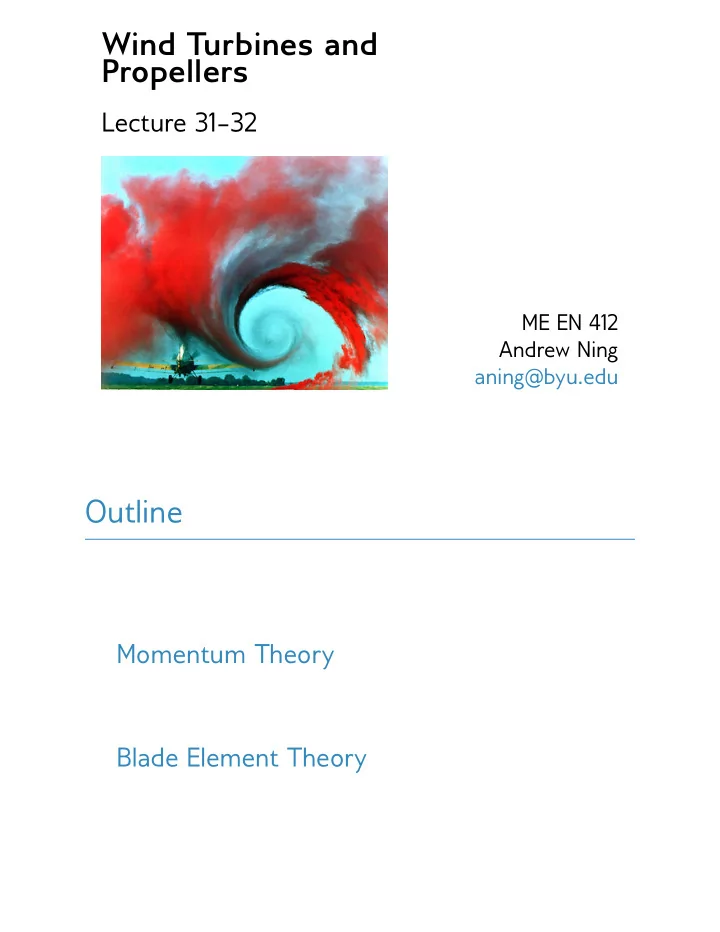

Wind Turbines and Propellers Lecture 31–32 ME EN 412 Andrew Ning aning@byu.edu Outline Momentum Theory Blade Element Theory
Momentum Theory Momentum Theory
mass balance: momentum balance: combine: It may not be obvious, that the pressure terms from the sides cancel (they do). We can come up with the same result more rigorously, with the below control volume. T A w A cv
Use a second control volume just across the disk (2-3) Recall V 2 = V 3 = V d and A 2 = A 3 = A d momentum balance: Control Volume 1: T = ρA 2 V 2 ( V 1 − V 4 ) Control Volume 2: T = A 2 ( P 2 − P 3 ) Combine: ρV 2 ( V 1 − V 4 ) = ( P 2 − P 3 )
We can find the pressure change from Bernoulli’s 1-2: 3-4: Combine: Replace pressure in previous thrust expression: ρV d ( V 1 − V 4 ) = ( P 2 − P 3 ) ρV d ( V 1 − V 4 ) = 1 2 ρ ( V 2 1 − V 2 4 ) V d ( V 1 − V 4 ) = 1 2( V 1 − V 4 )( V 1 + V 4 ) V d = 1 2( V 1 + V 4 )
Thus, the velocity at the disk is half way between the upstream and downstream velocity. V ∞ − 2 u V ∞ V ∞ − u Recalling the importance of nondimensional numbers: V d = V ∞ − u � � 1 − u = V ∞ V ∞ = V ∞ (1 − a ) Similarly, we know: V w = V ∞ (1 − 2 a )
Thrust: Thrust Coefficient: T C T = 1 2 ρV 2 ∞ A d = 4 a (1 − a ) Angular Momentum Balance � � � � � r × � � V m = ˙ Q S
Velocity triangle*: Ω r W V ∞ *This is an unconventional frame of reference and orientation for a wind turbine, but I use it because it will be more familiar to you as it matches the style of the book. Ω r W V ∞ V ∞ V ∞ 2 a
Ω r W V ∞ V ∞ Ω r 2 a 0 V ∞ 2 a Ω r W V ∞ V ∞ Ω r 2 a 0 V V ∞ 2 a
Ω r W W Ω r V ∞ V Ω r W V ∞ V ∞ Ω r 2 a 0 V V ∞ 2 a Apply angular momentum balance:
mass flow rate: Torque: Torque Coefficient: Q C Q = 1 2 ρV 2 ∞ A d r = 4 a ′ (1 − a ) λ r where λ r = (Ω r/U ∞ ) is called the tip speed ratio
Momentum Theory: C T = 4 a (1 − a ) C Q = 4 a ′ (1 − a ) λ r 1.0 C T 0.8 0.6 C P 0.4 0.2 0.0 0.0 0.1 0.2 0.3 0.4 0.5 a
Blade Element Theory
Blade Element Theory Velocity triangle at the blade, in the reference frame of the blade: Ω r (1 + a 0 ) plane of rotation φ U ∞ (1 − a ) W angle of attack: lift and drag coefficients: normal and tangential force coefficients:
elemental thrust: elemental torque: thrust coefficient: torque coefficient:
find W from velocity triangle: Local solidity: σ ′ = Bc 2 πr Local tip-speed ratio: λ r = Ω r U ∞
Momentum Theory: � 2 � 1 − a c n σ ′ C T = sin φ � 2 � 1 + a ′ c t σ ′ λ 2 C Q = r cos φ If we equate these two theories we can solve for the unknown induction factors σ ′ c n a = 4 sin 2 φ + σ ′ c n σ ′ c t a ′ = 4 sin φ cos φ − σ ′ c t
Problem: φ depends on a and a ′ Ω r (1 + a 0 ) plane of rotation φ U ∞ (1 − a ) W Conventional Solution: Fixed point iteration, or a 2D root solve. New Problem: does not always converge.
Better Solution ∗ : Change variables to φ and W : Ω r (1 + a 0 ) plane of rotation φ U ∞ (1 − a ) W sin φ cos φ R ( φ ) = λ r (1 + a ′ ( φ )) = 0 1 − a ( φ ) − ∗ Ning, A., “A Simple Solution Method for the Blade Element Momentum Equations with Guaranteed Convergence,” Wind Energy, Vol. 17, No. 9, Sep. 2014, pp. 1327–1345, doi:10.1002/we.1636. Algorithm Avg. Function Calls Failure Rate (%) Fixed-Point 31.8 12.6 Newton 79.0 5.8 Steffensen 16.4 16.3 Powell Hybrid 72.3 16.2 Levenberg-Marquardt 92.3 8.8 New Method 11.3 0.0
Recommend
More recommend